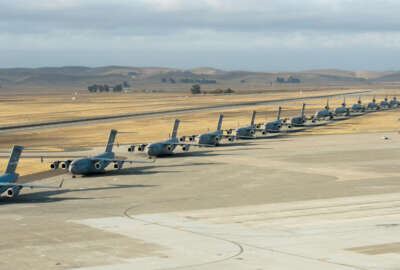

Digital tools to help plan flight routing are already saving 200,000 gallons of fuel per week in one region, and the savings could soon grow to a million gallons.
The Air Force, the government’s largest fuel consumer, wants to use its market power to help spur the development of new innovations like ultra-efficient airplanes and new types of fuel. But if those energy-saving investments pan out, they’re likely to take a while.
In the much nearer term, officials see big promise in software, where the service is finding ways to save hundreds of thousands of gallons of fuel each week, with more on the way.
One major example is an application called Jigsaw. The Air Force launched it as a partnership with the Defense Innovation Unit in 2017, but by last year, it was being used for every single aerial refueling mission run by the 609th Air Operations Center at Al Udeid Air Base in Qatar.
Previously, those missions had been planned out on whiteboards. Jigsaw digitized the process, making routes more efficient, and it’s already saving about 200,000 gallons of fuel per week. New automated planning features the Air Force is adding have the potential to increase those savings as much as five-fold, said Roberto Guerrero, the deputy assistant secretary of the Air Force for operational energy.
“We think that auto planning feature is going to get us another 10% to 15% efficiency gain … and just that one air operations center will go from roughly about 200,000 gallons of fuel saved per week to about a million gallons per week,” he said at a conference hosted by the Air Force Association this week. “That’s fuel that can be used elsewhere, and it really allows our operators to execute the mission more effectively, because the planning time is reduced dramatically, from a 12-hour plan to a four-hour plan. This turns, let’s say, a 50-tanker schedule into a 48-tanker schedule, which means that those other tankers can go somewhere else to provide support to combat operations.”
The next step is a program called Magellan, developed by the Air Mobility Command software factory known as Conjure. If Jigsaw can help with automated tanker planning over the short term, Conjure is expected to do similar things over longer time frames — and over much bigger geographic areas.
“And the idea is that once we start looking at how do we do a better job of scheduling tankers in one theater, we make sure that the allocation process is well spread throughout the world, so that airplanes are in the right places to either conduct training or conduct combat operations,” Guerro said. “It also gives us a good sense of what the requirements are for the future few months in order to place those aircraft in the right places.”
Meanwhile, another software factory hosted by Pacific Air Forces, called Tron, is trying to do similar things to automate the process of scheduling air crews for training.
Guererro said that effort grew out of the fact that the manual processes for managing training currencies were overly complicated, leading to training lapses and decreased readiness.
“It’s currently focused on the C-17 community, but we’re looking to expand, and the idea is similar to Jigsaw and Magellan in that you’re automating the way we schedule,” he said. “It reaches into our requirements system, and comes back and says, ‘these are the crews that need training tomorrow, and these are the instructors that can provide that training to those crews.’ We think it will result in making sure that the right crew are getting the right training at the right time and increasing readiness.”
Meanwhile, the Air Force has been increasing its focus on how fuel supplies and fuel logistics will play a role in potential future military engagements by building those considerations into its wargaming exercises.
Guererro said in the Pacific theater, for example, logistics considerations were already a part of those exercises, but they tended to focus on other logistics concerns such as ammunition.
“We weren’t really looking at energy the way we thought we needed to, so we hired somebody to help us engage with the wargaming community to take a better look at it – initially to observe, and then we built it into Global Engagement 18,” he said. “We wanted to make sure we understood what the impacts were – how many mission cancellations were from fuel logistics because of attack and other things, as opposed to other causes. And it was not insignificant.
Since that 2018 event, the Air Force has expanded the fuel-based wargaming to also incorporate how energy considerations play into joint operations. One such exercise happened last year.
“In the Pacific, we rely on the Navy for certain things, the Navy relies on us for certain things, and we want to get a better understanding of what the [fuel] requirements and realistic shortfalls could be between us and the Navy, and how that’s going to impact us,” he said. “We’re going to continue to expand that [wargaming] capability, because we think it’s important for us to decide where we’re going to base our aircraft and what kind of technologies we’re going to go after. We have to understand the risks that are out there, and how we’re going to buy things and move to places where the risks are reduced.”
Copyright © 2025 Federal News Network. All rights reserved. This website is not intended for users located within the European Economic Area.
Jared Serbu is deputy editor of Federal News Network and reports on the Defense Department’s contracting, legislative, workforce and IT issues.
Follow @jserbuWFED


